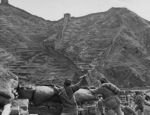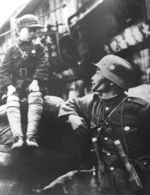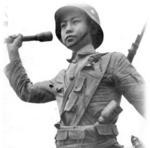Model 24 Stielhandgranate Grenade
| Country of Origin | Germany |
| Type | Grenade |
| Diameter | 70.000 mm |
| Length | 360.000 mm |
| Weight | 0.600 kg |
Contributor: C. Peter Chen
ww2dbaseNicknamed "stick grenades" or "potato mashers", the Model 24 Stielhandgranate grenades were introduced into German service in 1915; the general type commonly used in WW2 originated from the 1924 variant. The explosives situated inside thin sheet metal cylinders at the top of the hollow handles were ignited by friction igniters, a design common among German grenades of the period but unusual in designs originating from other countries. To trigger the friction igniters, the operators would typically hold the handles with one hand while the other hand pulled an exposed cord at end of the handles opposite of the cylinders; the grenades would occur about five seconds after pulling the cords. Each Model 24 grenade carried 170 grams of high explosives. The blast radius was about 10 to 12 meters. They were typically transported in metal crates each carrying 15 grenades, with igniters separated from the grenades. A smaller number of smoke (marked with white band on the cylinder and at times with different-shaped handles), training (without explosives), and cold weather (marked with "K" on the cylinder) variants were also produced. ww2dbaseLast Major Revision: Apr 2011
Model 24 Stielhandgranate Grenade Interactive Map
Photographs
 |  |  |  |
Please consider supporting us on Patreon. Even $1 per month will go a long way! Thank you. Please help us spread the word: Stay updated with WW2DB: |
Visitor Submitted Comments
2. Anonymous says:
11 Jan 2012 05:08:08 AM
i have a german hand gun the last model 4 1928-1929 with the small lettering and the N with crown. i have seen info published that the serial numbers were 480,000 to 500,000 and the author states he has seen a few a litter earlier. i saw the polished steel or nickel plated one on the inter net but i believe it was done after market and has distorted it's value. My gun is guanine blue worn on tip from sliding in holster or use. The serial # is 263,918 could be first made in series? At least it should change the numerical issue. What do you think the value of such a low sidereal number by almost half, of whats thought to be the starting number. And would it be worth more to a privet collector or at auction? I collect a lot of thing and I like guns would it be a nice start to a collection as a unique pice do to serial number. It was given to me i also would like to know if and how i could trace it to its original owner? And could it have been a german officer?
11 Jan 2012 05:08:08 AM
i have a german hand gun the last model 4 1928-1929 with the small lettering and the N with crown. i have seen info published that the serial numbers were 480,000 to 500,000 and the author states he has seen a few a litter earlier. i saw the polished steel or nickel plated one on the inter net but i believe it was done after market and has distorted it's value. My gun is guanine blue worn on tip from sliding in holster or use. The serial # is 263,918 could be first made in series? At least it should change the numerical issue. What do you think the value of such a low sidereal number by almost half, of whats thought to be the starting number. And would it be worth more to a privet collector or at auction? I collect a lot of thing and I like guns would it be a nice start to a collection as a unique pice do to serial number. It was given to me i also would like to know if and how i could trace it to its original owner? And could it have been a german officer?
3. Anonymous says:
31 Oct 2020 02:17:14 PM
How many of these were made?
31 Oct 2020 02:17:14 PM
How many of these were made?
All visitor submitted comments are opinions of those making the submissions and do not reflect views of WW2DB.
Search WW2DB
News
- » US Government Plans to Purge WW2 Information (17 Mar 2025)
- » WW2DB's 20th Anniversary (29 Dec 2024)
- » Wreck of USS Edsall Found (14 Nov 2024)
- » See all news
Model 24 Stielhandgranate Grenade Photo Gallery
 |
Current Site Statistics
- » 1,159 biographies
- » 337 events
- » 44,601 timeline entries
- » 1,243 ships
- » 350 aircraft models
- » 207 vehicle models
- » 376 weapon models
- » 123 historical documents
- » 261 facilities
- » 470 book reviews
- » 28,639 photos
- » 429 maps
Famous WW2 Quote
"All that silly talk about the advance of science and such leaves me cold. Give me peace and a retarded science."Thomas Dodd, late 1945
Support Us
Please consider supporting us on Patreon. Even $1 a month will go a long way. Thank you!
Or, please support us by purchasing some WW2DB merchandise at TeeSpring, Thank you!
9 Mar 2009 10:04:03 AM
Artillery school at Fort Sill, OK. was my first introduction to Artillery learned everything. However, training was rushed due to the demands of the Viet Nam War. Small arms training used M-14, M-3 Grease Gun, Thompson M-1928, Colt M-1911 Pistol, Browing M-2 Fifty Caliber Machine Gun, .30 Caliber M-1 Carbine ,the Old Bazooka, M-79 Gernade Launcher and M-60 Machine Gun.Training on the M-114A1 155mm Howitzer, 175mm Howitzer and 8inch Howitzer.